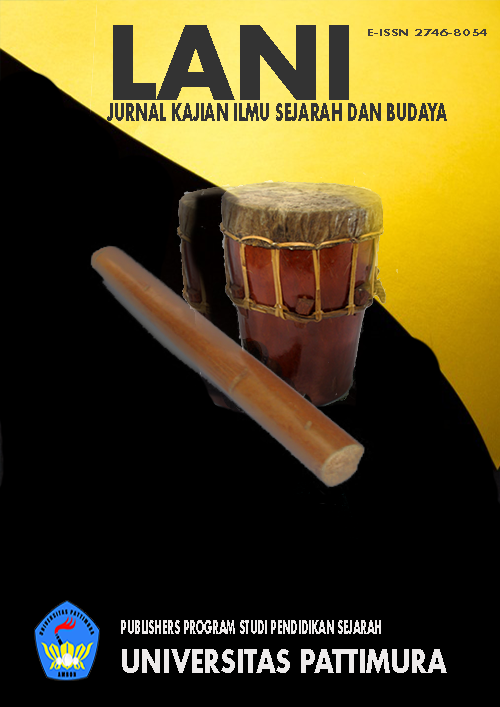Sasi Dalam Menunjang Sustainable Ekonomi Masyarakat Adat Saparua
Sasi in Supporting the Sustainable Economy of the Indigenous Community of Saparua
Abstract
This study aims to reveal information about Sasi, which has the principle of sustainability and balance of the relationship between humans and nature, as well as humans and their creators, of course, in line with sustainable living. This research is unique because it explicitly supports a sustainable community economy. An in-depth study using qualitative research is needed to determine how Sasi supports the economic sustainability of the Saparua people. Interviews and observations are the methods used to collect data. After that, an interactive analysis was carried out. The results show that sasi can be implemented to manage quality and economically valuable biological and vegetable natural resources products. Sasi helps every proponent of the economy. For example, the selling price of natural resources of sasi is more profitable because the harvest is abundant in quantity and has a higher selling value because of its quality.
Downloads
References
Ali, M (2014) Memahami Riset Perilaku dan Sosial ; Jakarta : Penerbit Bumi Aksara
Affandi, D &Wulandari, P (2012) An Exploration Local Wisdom Priority in Public Of Local Government Case Study in East Java: Journal. Eco. Res., vol.3(5) 61-76
Ali, M (2017) Sustainability Education Curriculum Development. Bandung: Upi Press.
Bartels, D (1977) Guarding the invisible mountain : intervillage alliances, religious syncreticism and ethnic identity among Ambonese Christians and Moslems in the Moluccas. Disertation. Cornell University
Capra, F (2007) Sustainable living, Ecolgocal Literacy and the breath of life. Canadian Journal o environmental education. PP, 10-18.
Cooley, F.(1961) Altar and Throne in Central Moluccan Societies: A Study of the Relationship Between the Institutions of Religion and the Institutions of Local Government in a Traditional Society Undergoing Rapid Social Change. Disertation. Yale University
Cooley, F.L (1987) Mimbar dan Tahta. Jakarta : Peneibit Pustaka Sinar Harapan
Creswell, J.W (1997) Qualitative inquiri and research design ; chosin among five tradisions : London ; united kingdom ; sage publucation
Ellen, R (2016) Nuaulu ritual regulation of resources, Sasi and forest conservation in eastern Indonesia. Journal South East Asia Research, 24, 1, pp 5–22doi: 10.5367/sear.2016.0290
Heal, G (1998) Valuing The Future: Economic Theory and Sustainability. New York. Columbia University Press
Jorgensen, D (1989) Observation Participation ; A Methodology For Human Studies. Newbury Park,London,New Delhi: Sage Publications
Liu, L (2009) Sustainability: Living within One’s Own Ecological Means. Journal sustainability. Vol 1, doi:10.3390/su1041412. ISSN 2071-1050. PP, 1412-1430;
Liliweri, A (2014) Pengantar Studi Ilmu Kebudayaan. Bandung : Nusa Media
Matitaputty, J.K (2016) Pendidikan Nilai Sosial Budaya DAlam KEluarga dan Lingkungan Masyarakat Suku Nuaulu di Pulau Seram. Jurnal PEdagogika dan Dinamika Pendidikan. Vol.4 No,1 Hal 76-87
Matitaputty, J.K (2018) Budaya Sasi untuk menunjang sustainable living pada masyarakat adat Saparua dan Preservasinya melalui Pembelajaran Ilmu Pengetahuan Sosial di Universitas Pattimura. Disertasi
Matitaputty, J. K Ali, M, Sjamsuddin, H, Maryani, E (2018) Contributions of Sasi to Sustainable Living of Saparua Indigenous Community, Indonesia. Advances in Social Science, Education and Humanities Research, volume 251. Published by Atlantis Press. Hal 685-691.
Matitaputty, J.K; Ali, M, Sjamsuddin, H, Maryani, E (2018) Model of Sustainable Development of Sasi from Maluku, Indonesia. Jour of Adv Research in Dynamical & Control Systems, Vol. 10, 04-Special Issue hal. 981-984.
Matitaputty, J.K dan Masinay, I (2020) The Ceremonial Procession and Meaning of Makan Patita in Negeri Oma – Maluku. Society, 8 (2), 298-312, 2020 P-ISSN: 2338-6932 | E-ISSN: 2597-4874 https://society.fisip.ubb.ac.id hal.299-321
Miles, M.,&Huberman, M (1990) Analisa Data Kualitatif. Jakarta: Universitas Indonesia Press
Nendissa dkk (1991) Upacara Tradsional Yang Berkaitan Dengan Peristiwa Alam Dan Kercayaan Daerah Maluku. Jakarta: Depdikbud
Nendissa, R. H (2010) Eksistensi Lembaga Adat Dalam Pelaksanaan Hukum Sasi di Maluku. Jurnal Sasi Vol. 16 No.4 PP: 1-6
Nendissa, A.R (2014) Kewang’s Socio-Economic Effects On Implementation Of Sasi ( A Case Study : In Ihamahu Village, Saparua Sub-District, Central Maluku Regency). Jurnal Agribisnis Kepualaun. Vol.2 No.2 PP: 25-37
Novazek, I, Herkes, I.H.T., Sopacua J., Tutuhey,M (2001) An Institutional Analyzis Of Sasi Laut In Maluku, Indonesia. Canada, Ottawa, Malaysia. Danida, IDRC Canada, ICLARM the World Fish center.
Pion R, et al (2017) A Student Guide to Sustainable Living at Boston College. Boston College Office of Sustainability to provide students, faculty, and staff with answers to questions about living and working sustainably on BC’s campus
Renjaan, Justine, Purnaweni, Hartuti, & Anggoro, Didi Dwi. (2013). “Studi kearifan lokal Sasi kelapa pada masyarakat adat di desa Ngilngof kabupaten Maluku Tenggara”. Jurnal Ilmu lingkungan. Volume 11 Issue 1: 23-29 (2013). Semarang: Undip
Report Of The World Commission On Environment And Development: “Our Common Future (1987) Development And International Economic Co-Operation: Environment. United Nation.
Sugiono (2008) Memahami Penelitian Kualitatif. Bandung: Alfabeta
Thorburn, C (1998) Sasi Lola (Trochus niloticus) in the kei island, moluccas: and endangered coastal resource management tradisional. Indonesia journal of Coastal and marine resource ISSN 1410-7821, Volume 1, No. 2, 1998 PP. 52-70
Thorbun, C (2000) Changing customary marine resource management practice and institutions: the case of sasilola in the Kei Islands, Indonesia. Journal World Development Vol.28 No.8 PP:1461–1479.
Uneputty dkk (1985) Upacara Tradisional yang berkaitan dengan peristiwa alam dan kepercayaan daerah Maluku. Jakarta: Departemen Pendidikan dan Kebudayaan Proyek inventarisasi dan Dokumentasi Kebudayaan Daerah.
Copyright (c) 2021 Jenny Koce Matitaputty

This work is licensed under a Creative Commons Attribution-ShareAlike 4.0 International License.








